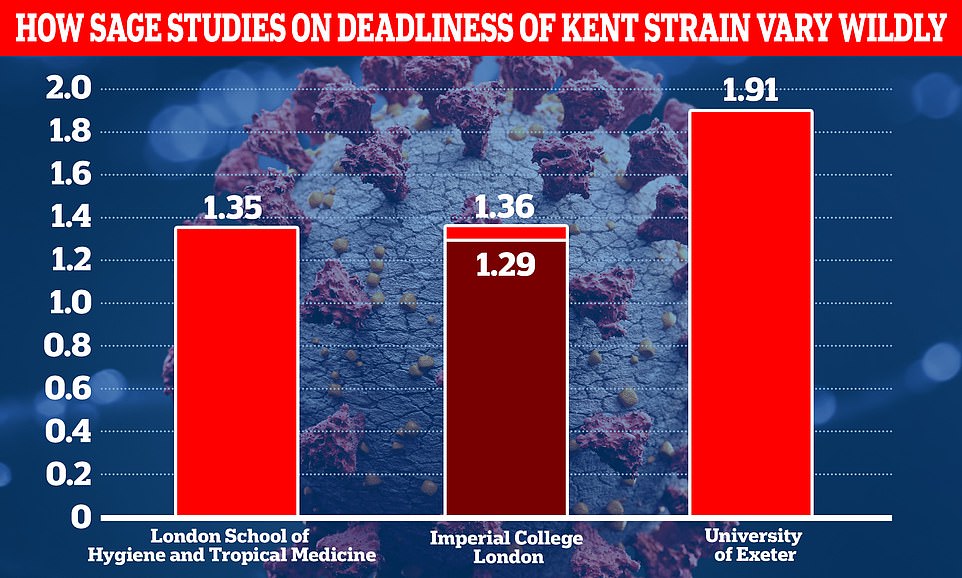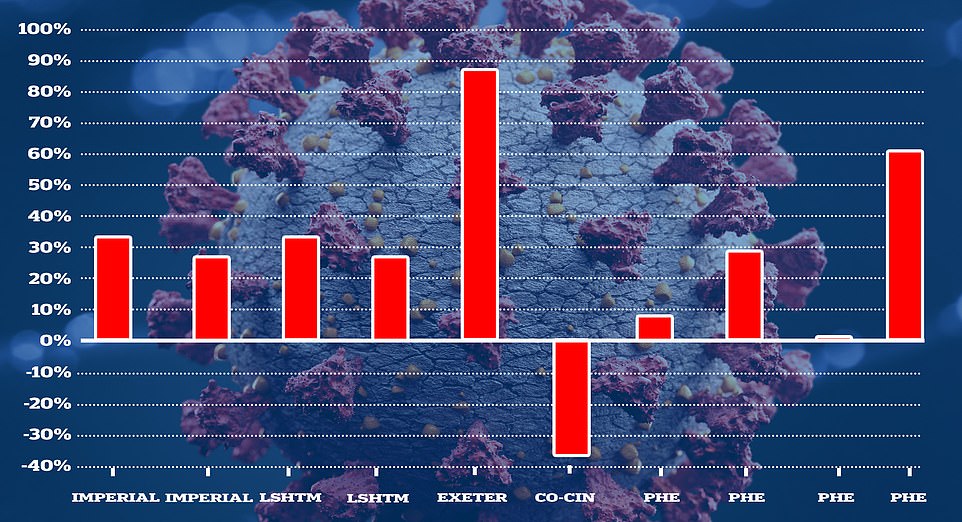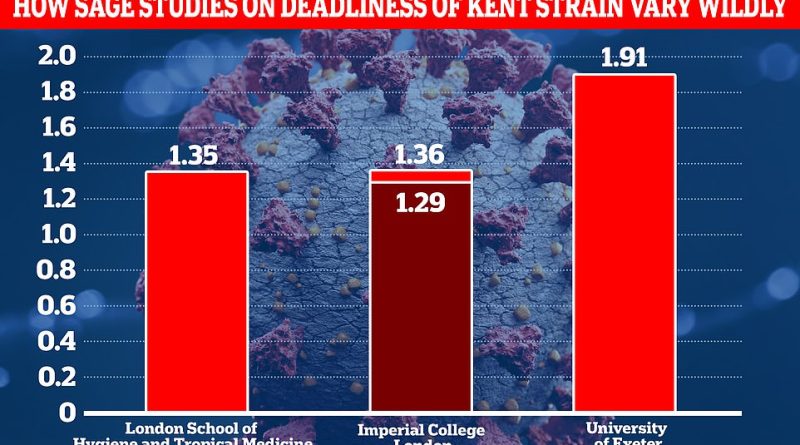Is Kent Covid variant REALLY deadlier? Confusion mounts as studies differ
There was confusion tonight about how deadly the Kent coronavirus variant really is after 10 SAGE studies came to wildly different conclusions about its lethality and the World Health Organization said it still hadn’t seen any convincing data.
Boris Johnson and his science chiefs tonight made the shocking claim that the strain — called B.1.1.7 — could be 30 per cent more deadly than older versions of the virus without presenting any evidence to back up the terrifying development.
The announcement came after 10 studies submitted to SAGE overwhelmingly suggested that the strain was more lethal than past variants. But there are question marks over the findings because the estimates varied vastly and one study even found the strain was less deadly than the older version.
The London School of Hygiene and Tropical Medicine estimated the risk of death from the new variant could be 1.35 times greater, Imperial College London said it was between 1.29 and 1.36 times, Exeter University found it may be 1.91 and Public Health England said it could be as high as 1.6. But there are further questions over the reliablity of the data because the research was only based on a few hundreds deaths.
Public Health England chief Dr Susan Hopkins cautioned people from reading too much into the findings and suggested the evidence was still murky. She added: ‘There is evidence from some but not all data sources which suggests that the variant of concern which was first detected in the UK may lead to a higher risk of death than the non-variant. Evidence on this variant is still emerging and more work is underway to fully understand how it behaves.’
Sir Patrick Vallance told the briefing tonight that hospital data had suggested the variant could increase the risk of death for a man his 60s from 1 per cent to 1.3 per cent, but he admitted ‘the evidence is not yet strong’. Adding to the confusion, Professor Chris Whitty, said he was not entirely convinced the strain was deadlier in the first place.
And thevariant has already been spotted in 60 countries, including most of continental Europe, the US, Australia, India, China and Saudi Arabia – yet none of those countries have reported a higher mortality rate from the new variant.
Kit Yates, a mathematical biologist at the University of Bath, slammed the Government for causing confusion and panic about the variant. He tweeted: ‘I really dislike the way the news about the increased lethality of B1.1.7 was leaked out and then discussed in a press briefing. Where is the data? We want to be able to scrutinise it and to understand the detail, not just the summary.’
The WHO also undermined No10, saying it had not yet seen any evidence to convince it that the Kent strain was actually more deadly than other strains. In a thinly-veiled jab at the UK Government, the body said it was more likely that the increased death rate was a result of ministers losing a grip on infections.
Dr Mike Ryan, chief of the WHO’s Health Emergencies Programme, told a separate press conference today: ‘There is a big difference between the lethality of a virus, how many people on average a virus kills, versus the mortality. If I have one million people infected and my lethality is 1 per cent, or two million people infected with a lethality of 1 per cent, twice as many people will die [in the second case].’


The Kent variant first emerged in the South East of England in October and quickly become the dominant strain in Britain, sparking a devastating winter wave of infections and hospital admissions which plunged the country into a third lockdown.
Studies have shown the Kent strain is between 50 and 70 per cent more infectious than the original version thanks to key mutations on its spike protein which make it easier to lock onto human cells. This gives it an evolutionary edge over other strains.
There were also fears that these same mutations could make the variant resistant to vaccines or natural immunity from previous infection. But data from UK studies suggest this won’t be the case.
Speaking at this evening’s Downing Street press conference, Boris Johnson said: ‘We’ve been informed today that in addition to spreading more quickly it also now appears that there is some evidence that the new variant, the variant that was first identified in London and the South East, may be associated with a higher degree of mortality.’
And the PM handed over to his chief scientific adviser, Sir Patrick Vallance, who explained: ‘If you took a man in their 60s, the average risk is that for a thousand people who got infected, roughly 10 would be expected to, unfortunately, die… with the new variant, for a thousand people infected, roughly 13 or 14 people might be expected to die. That’s the sort of change for that sort of age group.’
He added: ‘I want to stress that there’s a lot of uncertainty around these numbers and we need more work to get a precise handle on it, but it obviously is of concern that this has an increase in mortality as well as an increase in transmissibility, as it appears of today.
Professor Neil Ferguson, who sits on the SAGE subgroup NERVTAG and whose grim modelling that hundreds of thousands of Britons could die without action spooked ministers into the first lockdown last March, said today: ‘It is a realistic possibility that the new UK variant increases the risk of death, but there is considerable remaining uncertainty.
‘Four groups – Imperial, LSHTM, PHE and Exeter – have looked at the relationship between people testing positive for the variant vs old strains and the risk of death. That suggests a 1.3-fold increased risk of death. So for 60 year-olds, 13 in 1000 might die compared with 10 in 1000 for old strains.’
Public Health England refused to commit to a lethality figure. Dr Susan Hopkins, strategic response director at PHE said: ‘There is evidence from some but not all data sources which suggests that the variant of concern which was first detected in the UK may lead to a higher risk of death than the non-variant. Evidence on this variant is still emerging and more work is underway to fully understand how it behaves.’
The doom-mongering No10 press conference came despite an array of statistics that showed the second wave has peaked already and may finally be coming under control. SAGE today claimed Britain’s R rate has fallen below the crucial level of one and separate surveillance studies estimated daily cases have halved in a fortnight.
Department of Health figures mirrored the trend, with infections falling by 30 per cent week-on-week as health chiefs announced another 40,261 cases. Officials also posted 1,401 deaths, up just 9.5 per cent on last Friday. But experts warned the fatality toll will continue to rise for at least another week because of how long it takes for infected patients to become severely ill.
Defying mounting pressure to commit to easing the current measures, Mr Johnson warned today that the NHS is still under huge pressure and the curbs will only be lifted when it is ‘safe’. Downing Street was warned it faces the ‘mother of all battles’ next month when it has to discuss relaxing the restrictions.
The 70-strong Covid Recovery Group of Conservative MPs is urging the government to start lifting the lockdown no later than March 8 – when vaccines given to the most vulnerable groups should have taken effect.
But No10’s refusal to give an exact day for when lockdown will end may have been fuelled by worrying findings from scientists feeding into SAGE who sounded the alarm about the possible increased death risk of the variant.


